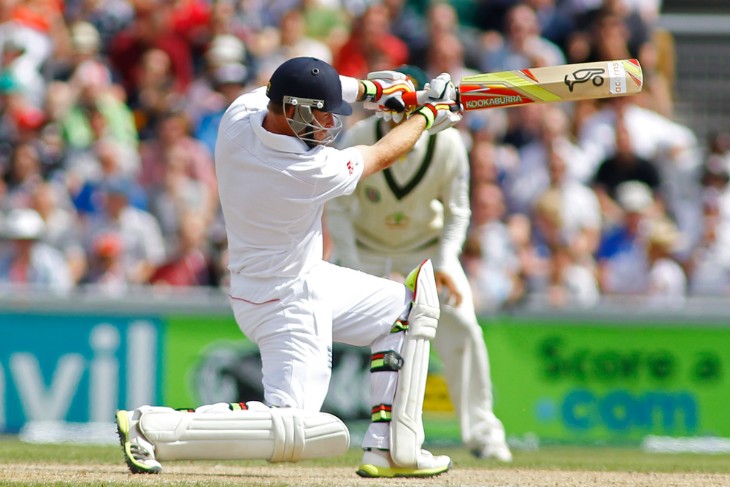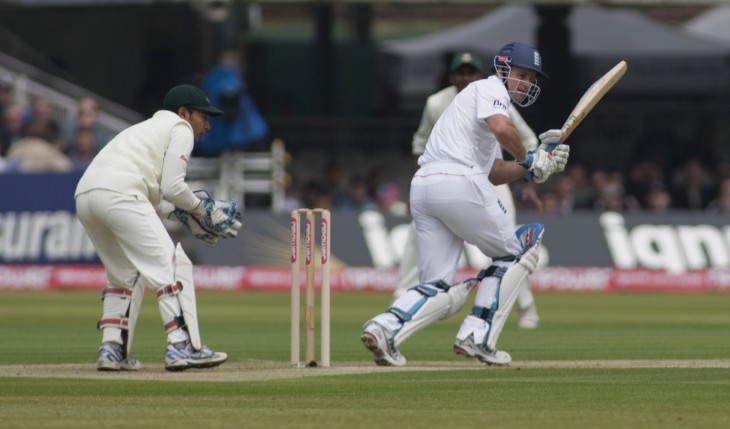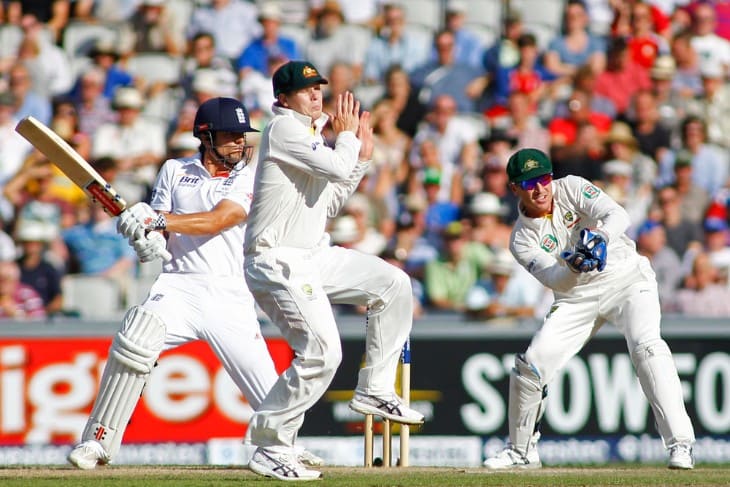Cricket, which is also called the “gentleman’s game,” is famous for its intricate rules and strategies. One of such rules that make this sport very complex is “follow-on”. Thus, both players and fans should know how to calculate follow-on in cricket as it can greatly affect the result of the game played. In this complete guide, we will look at what the considerations are for follow-on in cricket, simplify its calculations and look at impact.
What Is The Follow-On Rule?
In Test matches, there is a follow-on rule in cricket that allows the team batting first to send back their opponents to bat again straightaway under certain conditions. This concept aims at ensuring fairness during long format games.
For follow-on to be enforced three key conditions must be met:
- The side batting first must have a lead that exceeds 200 runs from the total runs made by the other side after their first innings.
- The required lead depends on the number of overs in the match; 150 or more runs are needed for five-day games while fewer days due to rain would reduce this requirement proportionally.
- Finally not bowled out, meaning still having wickets in hand allows a team batting first to enforce follow on.
Understanding these conditions is vital to both players and fans since they inform strategic decisions taken during Test matches. The follow on rule makes the game more interesting as it adds complexity and ensures equal chances for both teams.
Conditions That Must Be Met To Force A Follow On
Now let us go specifically into when a team can bring-in follow-on. According to Laws of Cricket, three main conditions ought to be satisfied:
First Innings Lead
In cricket, following on revolves around a term known as ‘first innings lead’. This means that an initial batting side of any test match has got to surpass substantially another side’s scores made in their first outing.
A minimum difference between innings totals needs reaching when enforcing follow-on – the innings side should score 200 runs more than the chase in their first innings. This ensures that the innings side has outscored their opponents by a considerable amount.
The intended effect of this condition is to create an uphill task for the chasing team. In other words, by achieving a lead of 200 runs or more, the innings side aims to pile pressure on the chasing team making it difficult for them to catch up with them within the match.
This provision of Test cricket adds strategy. Captains and teams must be careful about their batting performance not only as it relates to gaining runs but also establishing a significant lead. It is no longer merely about scoring but rather scoring well ahead of your opponent’s total runs.
Total Number Of Overs
Cricket’s follow-on rule is not all about the lead; it also incorporates into its purview the total number of overs bowled in a game. This aspect of rule ensures fairness especially in matches with varied duration.
Here is how:
In any five-day Test match, the team batting first can enforce the follow-on if it holds a 150-run lead over its second opponent in the first innings. This rule applies to most test matches.
However, cricket is a game that may be affected by various things, including weather. If such tests are reduced in duration because of rain or other things and are scheduled for less than five days, the required lead for following on will be proportionately reduced.
The reasoning behind this clause is simple enough. In a shorter match both teams get fewer opportunities to bat therefore the run lead required to put them back in again is lowered so as not to criminalize them out of being able to respond within the limited timeframe.
This particular aspect regarding the follow-on rule demonstrates how adaptable cricket rules can be adjusted according to different forms of matches conditions. It recognizes that some Test matches have shorter durations and sets their terms accordingly in order to maintain integrity.
It reveals why total overs in an innings are crucial when considering whether or not a team can impose a follow on. It makes sure that whatever number of overs available in any given contest, irrespective of its schedule time all around the world it would remain justifiable and fair.

Batting Terms
In cricket, however, this rule goes beyond merely looking at how much ahead one team has scored relative to another but they also consider how many wickets each has lost. This is known as “batting conditions” which help determine if a side should enact the follow-on or not.
How does this work?
Forcing them back into bat requires that their rivals batting score margin be sizeable enough against them usually about two hundred runs or more. However even then having achieved such lead one may only still do so provided he was not filled up completely.
Also referred to as bowled out it means that all the wickets have been taken away from a side during its first innings. Cricket is played by 11 players per side and each player gets out once they are dismissed. If a team still has wickets in hand then it means that they have some batsmen to follow.
The objective of this condition is to ensure that the follow-on decision is made only when the batting side of an innings is doing well. When a side loses all their wickets, it shows that they struggled during the first innings therefore enforcing the follow on may not foster fair competition.
The rule demands that there be wickets in hand, thus ensuring good performance by batmen in the first inning, before one can contemplate following on. This requirement fosters further scrutiny before any choice can be made by a team.
The Follow-On Rule’s “Batting Conditions” stipulate that for a team to enforce the follow-on, they should also have a lead and still have wickets at stake. It aims at finding balance between competitiveness and fairness in Test Match Cricket.
Now we will examine what goes into calculating whether or not a team can impose a follow-on after understanding these conditions.
Calculate Follow On Target
It is a simple process involved in the calculation of follow-on target in cricket, which requires application of a particular formula. This formula is widely used and accepted within various cricketing rules, including Google Docs. Here are steps on how to calculate follow-on target.
- First Innings Lead: Begin by calculating your team’s lead over the opponent’s first innings total. This is how many more runs your team has scored than its opposition.
- Formula: Lead = Team Total – Opposition Total
- Check Follow-On Condition: For follow-on to be implemented, it should be confirmed that the lead your team has fulfils this condition. In most regular Tests, this condition will be 200 or above but it can vary depending on whether the match has been reduced in any way.
- Formula: Follow-On Condition = 200 (or adjusted lead based on overs)
- Verify Batting Conditions: This means that at least you have wickets in hand as your team hasn’t been dismissed all out in its first innings.
- Formula: Wickets in Hand > 0
- Calculate the Follow-On Target: If your team meets all the conditions, you can calculate the follow-on target. This is the total number of runs the opposing team must score in their second inning to avoid the follow-on.
- Formula: Follow-On Target = Opposing Team's First Innings Total + 1 (run to avoid follow-on)
Strategic Considerations
Now that we've covered the calculations, it's essential to discuss the strategic implications of enforcing the follow-on. The decision to follow is not taken lightly and depends on various factors:
Pitch Conditions
In cricket, the conditions of the pitch play a significant role in determining whether the follow-on can be enforced. Pitch conditions can have a substantial impact on the outcome of a match, and teams need to consider these factors when making strategic decisions.
Here are some key aspects of pitch conditions that teams take into account:
- Pitch Quality: The quality of the pitch is a crucial factor. A pitch that offers consistent bounce and carry to the wicketkeeper is generally considered ideal for batting. However, pitches can deteriorate over time, developing cracks and uneven bounce, which can favour the bowlers.
- Spin-Friendly Pitches: Pitches that offer significant turn for spin bowlers can be challenging for batsmen, especially as the match progresses. Teams with strong spin bowlers may be more inclined to enforce the follow-on on such pitches, as they believe they can exploit the conditions to their advantage.
- Wear and Tear: As the match progresses and the pitch undergoes wear and tear, it can become more unpredictable. Bowlers may find it easier to extract movement from the pitch, while batsmen may struggle to score freely.
- Weather Conditions: Weather conditions, including moisture in the pitch due to rain or dew, can also influence pitch conditions. Moisture can assist swing and seam bowlers early in a match, making batting challenging.
- Pitch History: Teams often research the history of the pitch at a particular venue. Some pitches have a reputation for being conducive to high-scoring matches, while others are known for providing assistance to bowlers.

Bowling Workload
Here are some key aspects of bowling workload that teams take into account:
- Fatigue Levels: Bowlers, especially fast bowlers, can experience fatigue during a match, particularly if they have bowled a significant number of overs in the first innings. Fatigue can lead to a decrease in performance and an increased risk of injury. Teams assess the fitness and freshness of their bowlers before deciding on the follow-on. If key bowlers are tired, enforcing the follow-on may not be a wise choice.
- Injury Risk: Bowling extended spells can increase the risk of injuries, such as muscle strains or stress fractures. Teams are cautious about overburdening their bowlers, especially if the match has more days to go. Injury prevention is a top priority. If bowlers show signs of discomfort or risk, teams may opt against the follow-on.
- Variation in Bowling Attack: Teams evaluate the depth and variety in their bowling attack. If they have a diverse set of bowlers, they may be more inclined to enforce the follow-on, as it allows them to maintain pressure on the opposition. Having a well-balanced bowling attack can be an advantage when enforcing the follow-on.
- Pitch Conditions: As mentioned earlier, pitch conditions can change over the course of a match. Teams consider how the pitch is likely to behave in the upcoming innings and whether it favours their bowling attack. Pitch conditions, particularly if they are expected to deteriorate, can influence the decision regarding the follow-on.
Weather Conditions
Weather conditions play a significant role in cricket and can impact the decision to enforce the follow-on. Teams need to consider how weather conditions, including rain, can affect the match dynamics and their strategy.
Here are some key aspects of weather conditions that teams take into account:
- Rain Interruptions: Rain can interrupt play in cricket, leading to delays or even abandoned days of play. When enforcing the follow-on, teams must assess the weather forecast to determine if there's a high likelihood of rain that could disrupt their plans. Teams may be reluctant to enforce the follow-on if rain is expected, as it could result in less time for their bowlers to dismiss the opposition.
- Pitch Moisture: Rain can add moisture to the pitch, making it more conducive to seam and swing bowling. Teams consider how pitch conditions may change after rain and whether it benefits their bowling attack. In some cases, teams may choose to enforce the follow-on if rain is expected, as it could provide their bowlers with favourable conditions.
- Match Duration: Rain interruptions can lead to a reduction in the number of overs bowled in a match. Teams assess how these interruptions affect the overall duration of the match and whether it impacts their chances of securing a result. If rain is expected to significantly shorten the match, teams may be more inclined to enforce the follow-on to maximize their chances of winning.
- Deterioration of Pitch: Extended rain delays can lead to pitch deterioration. Teams evaluate how the pitch is likely to behave after rain and whether it aligns with their strategy. Pitch deterioration can favour spin bowlers, and teams with strong spin options may consider enforcing the follow-on.
Final Verdict
In conclusion, knowing how to calculate follow-on in cricket is vital for strategizing in longer-format matches. The follow-on rule adds a layer of complexity and strategy to the game, ensuring fairness and competitiveness. Teams must carefully assess the conditions and factors before deciding whether to enforce the follow-on or not. So, the next time you watch a Test match, you'll have a deeper understanding of this intriguing aspect of cricket.


